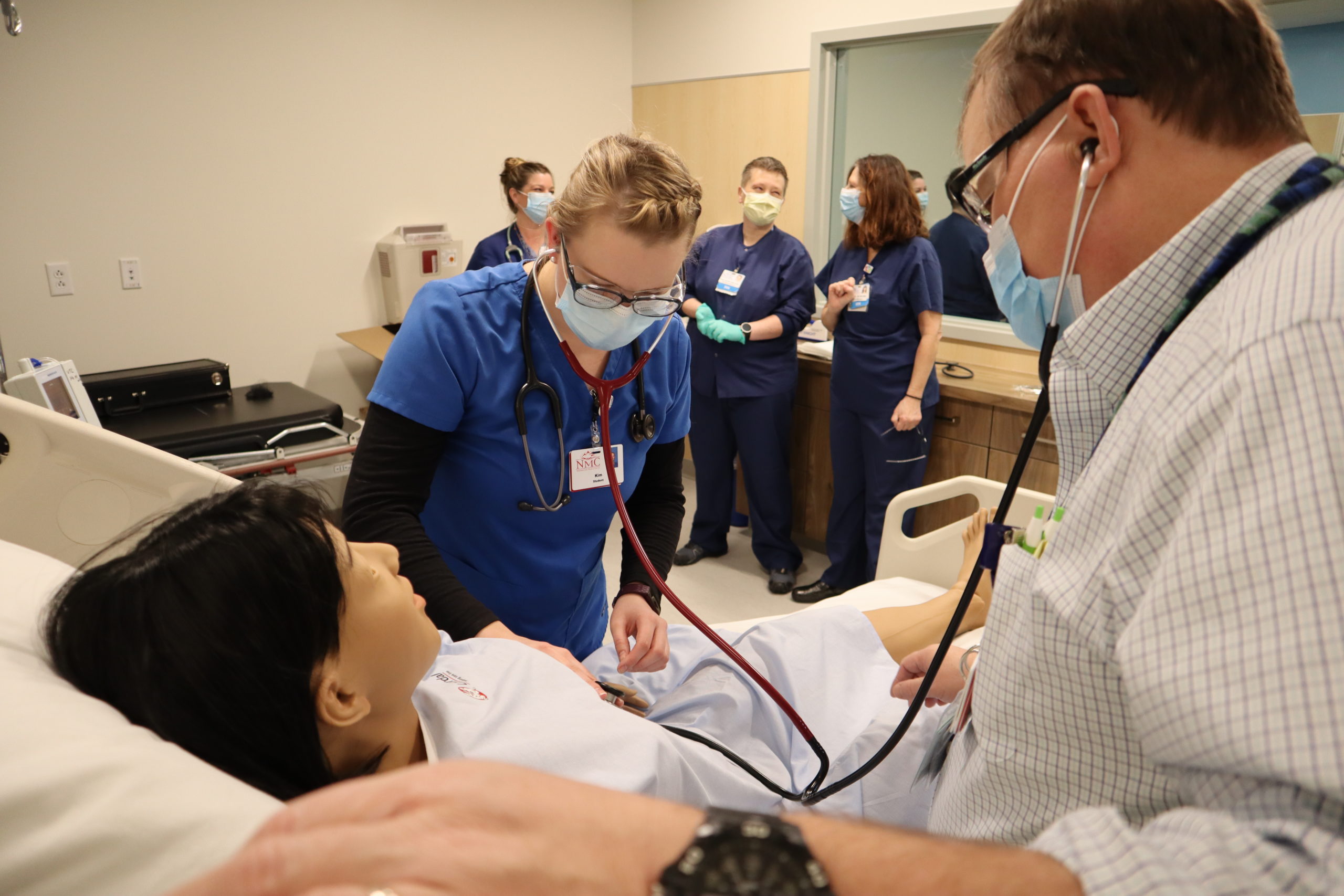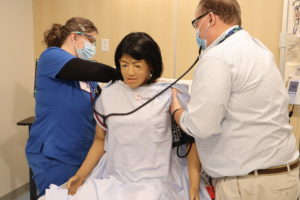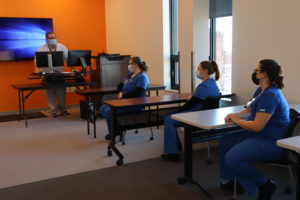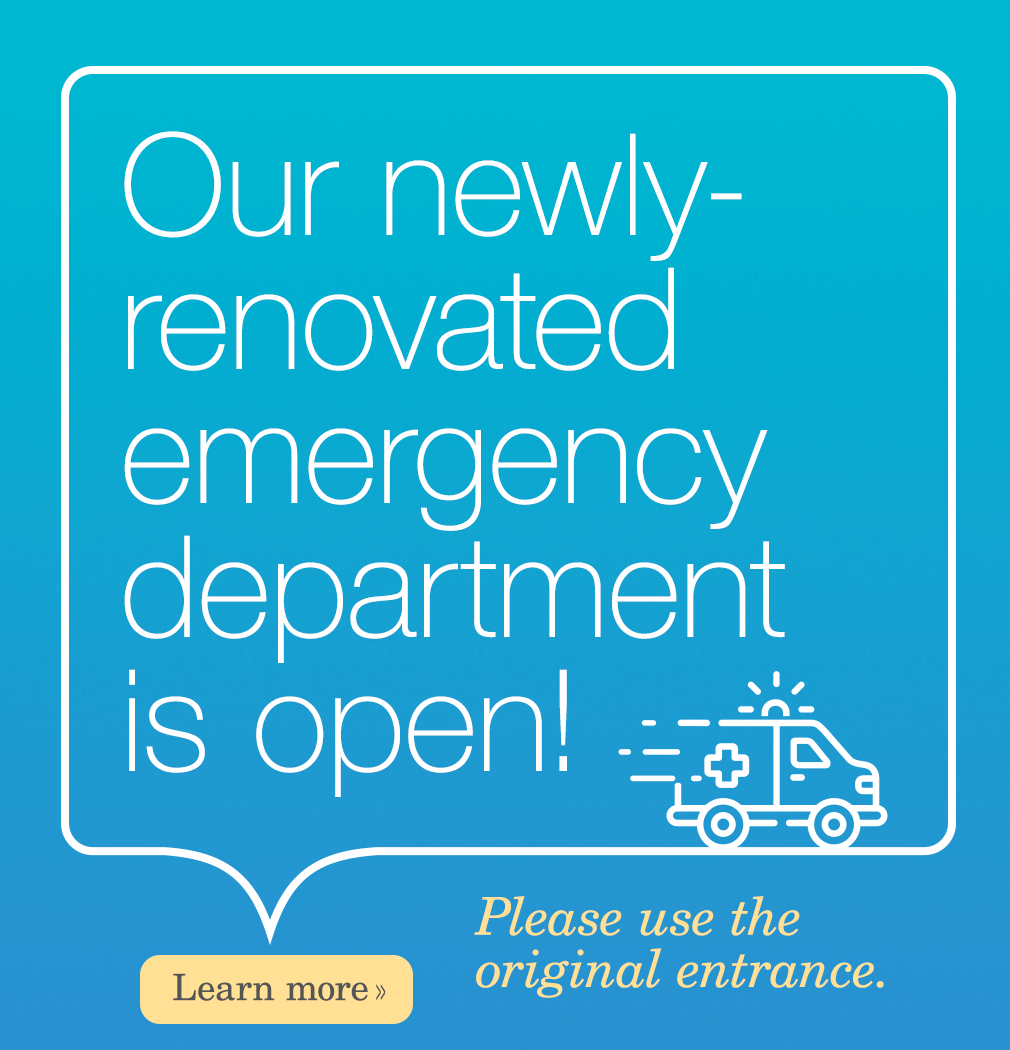

Sim Lab Provides Safe Environment for Learning
Serving its long-awaited purpose as a center for healthcare outreach and education, the new building at Congress and Main is home to the Nursing Education Program – a collaborative effort of NMC, Vermont Tech (VTC) and the Community College of Vermont (CCV), to increase local nursing opportunities.
The recently established COVID Vaccination Clinic is also located on the third floor of the building, adjacent to the nursing program’s space.
“The new building at Congress and Main has given VTC a classroom with video-conferencing ability, a skills lab and a simulation lab,” says Sarah Billings-Berg, DC, DNP, RN, CNE, the Associate Dean of Nursing at Vermont Tech.
The long-standing partnership continues to enable students to complete their practical training at NMC. Previously located at the CCV site on South Main Street, spatial limitations prevented a program laboratory, requiring students to travel to Williston for simulation-based training.
“Having the education center downtown and in one space is much more convenient for our students and faculty,” says Billings-Berg.
“The simulation lab has been built with the intention of replicating a hospital room at NMC. This gives students an opportunity to become comfortable and familiar with their clinical practice setting, as well as practice acute-care patient scenarios in a safe, lower-stakes setting.”
The immersive learning style of the Sim Lab remains an invaluable part of a medical education and has been a feature of VTC’s curriculum since 2010.
“Nurses are hands on learners,” says Kelly Campbell, BSN/RN, Manager of Clinical Education at NMC. “That’s the best kind of training for someone who’s in the healthcare field.” 
Campbell, along with Deanna Orfanidis, Chief Nursing Officer at NMC, developed the logistical aspects of the Nursing Education Program, from the design of the Sim Lab layout to arranging the training for instructors on simulation tools.
Campbell and Orfanidis worked closely with VTC’s Simulation Program Director, Michelle Stearns, DNP, MSN, RN, to research and choose appropriate simulation equipment and the best means for implementation.
“Learners interact with the simulator in an environment designed to be as real as possible to let them experience the whole patient encounter,” says Stearns. The use of human patient simulators (HPS) allows students to apply and demonstrate key nursing concepts, repetitiously.
Be it an emergency environment or inpatient room, the flexible design of the Sim Lab can mimic any clinical scenario, offering built–in wall suction, oxygen lines and cardiac monitoring. Students practice on a high-fidelity manikin rather than a live patient, including starting an IV and inserting a catheter or NG tube. The manikin prompts students in their patient-assessment through vital sign cues, such as pupil dilation, rate of pulse, circulation, and rate of breath through chest rise and fall.
The high-fidelity manikin incorporates computer hardware technology, often wirelessly, and can be programmed for various patient presentations. Sim Lab scenarios are digitally recorded through a learning management system, allowing students to examine their own performance afterwards.
“You can see the learners improving with each simulation experience,” says Stearns. “Simulation has been shown to improve student confidence, medication administration, teamwork, and clinical reasoning.”
VTC says their students and faculty have been positive in their evaluation of simulation use as part of the program’s curriculum.
“Reinforcing theoretical learning and transferring it to the simulated clinical setting is an evidence-based teaching strategy that is supported by state boards of nursing and national nursing education accreditors,” says Billings-Berg.
Vermont allows up to 25-percent of clinical time to be simulation based, which is especially useful during COVID when fewer students can be on units at any given time. Remote learning has replaced classroom work, yet students train together in the Sim Lab, and have clinicals at NMC two days a week in a live environment.
“By holding clinical rotations at NMC and sharing space with NMC staff at the education center, students already have a foot–in–the–door for future employment,” says Billings-Berg.
Meaningful Path
Campbell and Orfanidis diligently put together NMC’s Nursing Scholarship Program, its application process, and requirements. Tuition is awarded to qualified students who, in return, agree to work at NMC post-graduation. The program’s seat capacity is currently 18 with potential for growth as capabilities expand.
“The new space is bigger than our classroom at CCV was, allowing VTC to increase student numbers at the St. Albans location,” Billings-Berg says. “This will positively impact sustainability for the site and NMC will have a pool of excellently trained new nurses at their door-step.” 
Another aspect of the community partnership is in the hiring of NMC staff to serve as program instructors. “This allows us to professionally develop one of our own into an instructor,” says Campbell, which makes for a meaningful career path for nurses, locally.
Two of NMC’s veteran nurses have been hired to serve as part-time instructors in the program, Heather Smith, RN, and Pam Scott, ED RN. With the need for nursing educators at an all-time high across the country, Billings-Berg says the more practical experience a nursing instructor has, the better equipped they are for teaching.
“It is important for students to know that they are learning from a nurse who is competent in their hands-on practice,” she says. “The more we can grow our own at local community hospitals and with our clinical partners, the higher our faculty retention.”
CCV remains a major contributor to the nursing program pipeline at Vermont Tech, offering pre-requisite courses such as Human Anatomy, Physiology and Nutrition.
“Many of our students take courses at CCV prior to enrolling in the nursing program,” says Billings-Berg. “We partner with CCV at most of our locations state-wide and evidence shows that students who begin their health profession journey at CCV before coming to VTC can be successful.”
The field of nursing offers countless opportunities to contribute to the health of others, with a multitude of roles to be filled, both locally and globally.
“We need compassionate, caring and competent individuals who are motivated to perform their role to the fullest, every day; be life-long learners, and step–up as leaders in their speciality,” Billings-Berg says.
Campbell expresses gratitude for Vermont Tech’s deep expertise in nursing education and simulation labs, “Our relationship has grown stronger over the last year or two. I couldn’t ask for a better partner in developing all this,” she says.
“I truly love simulation, from design to implementation, and find that it offers a way to collaborate with multiple healthcare organizations around the state,” says Stearns. “Everyone working together to achieve better patient outcomes – it’s a good thing.”
Story by: Sarah Parsons West; for Northwestern Medical Center, 2021

